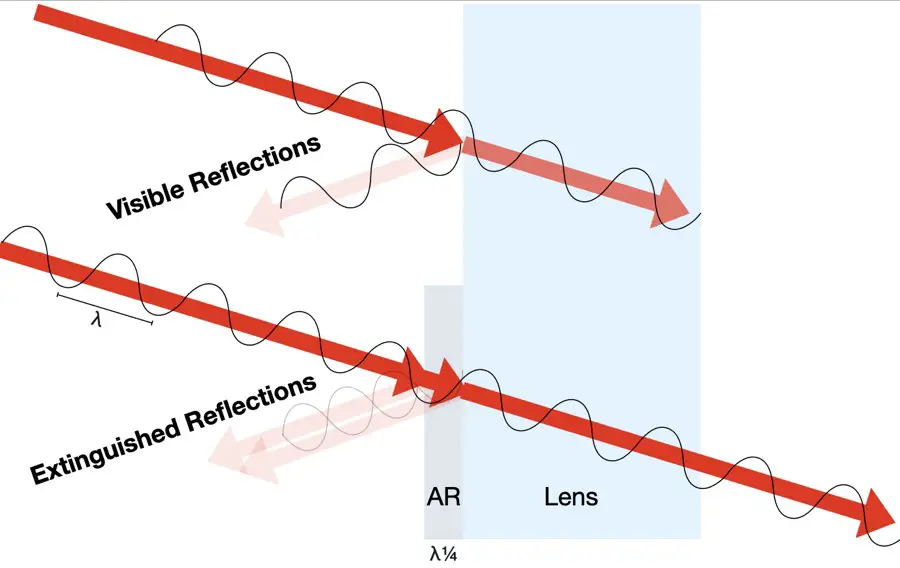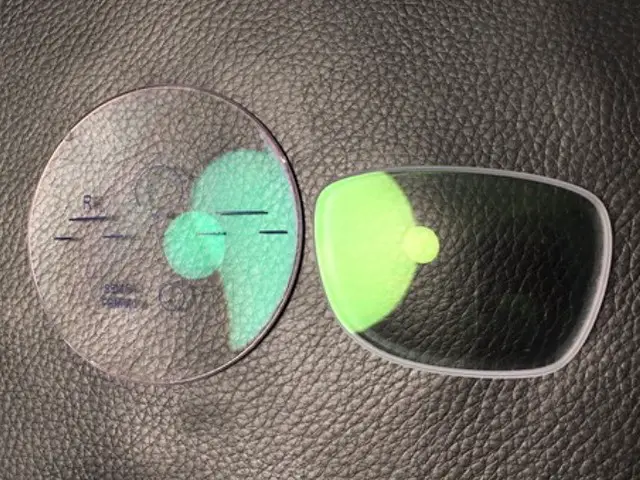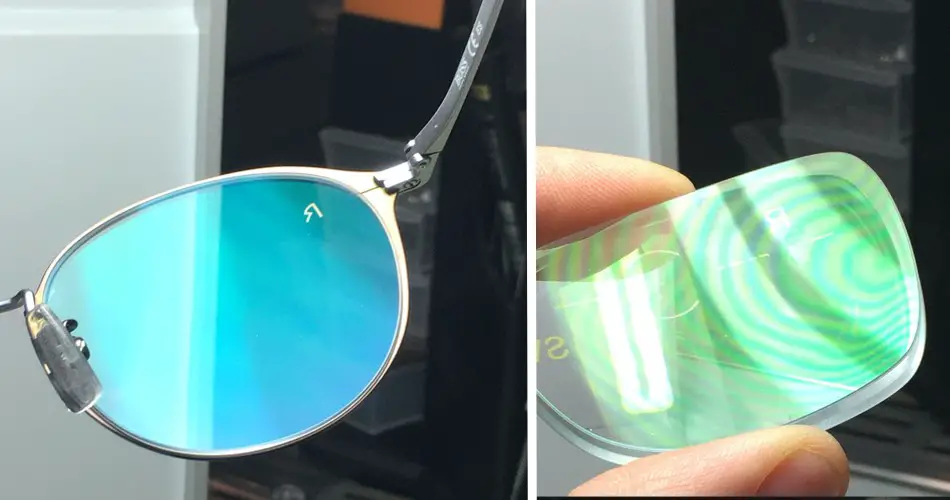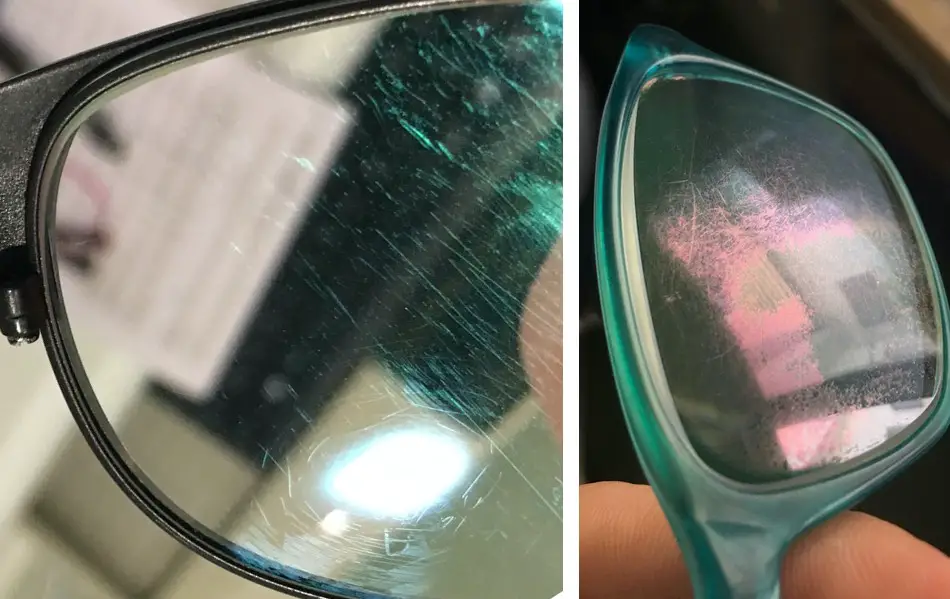How Does Anti-Reflection Coating Work?
An anti-reflective coating works by meeting two conditions I will break down here for an easy understanding.
When light hits the surface of the lens it comes in different wavelengths. Some of those wavelengths are more dominant when it comes to reflections. An anti-reflective coating aka AR minimizes those reflections.
By matching the thickness of the anti-reflective coating to the exact wavelength of the light you meet the first necessary condition (Path Condition). The coating must be ¼ as thick as the wavelength you want to minimize.

When the selection of the coating’s material is perfect the amplitude of the wavelength is the same in the lens material and the coating. In such a case the reflections are extinguished (Amplitude Condition).
This is very simply put together here for coatings with one layer. In real life, anti-reflective coatings are multilayered to get the best performance for you. The principles are the same.
What Is the Main Purpose of an Anti-Reflection Coating?
The main purpose of the AR is to make the lenses more transparent. This way the wearer looks more natural and can look easier through the lenses.
Is It Worth It to Get Anti-Reflective Coating?
Depending on the environment you want to wear your anti-reflective coating it might be a good idea for you to order the anti-reflective coating with your lenses. For most people it is a great option and worth the additional cost. Someone that is talking to you can see your eyes more easily and you do not have to deal with reflections on the back surface of your lenses.
However, if you work in an environment that is really hot it might be better for you to stay away from an anti-reflective coating. The reason is the coating will not last long if you put heat often on it. And if the anti-reflective coating breaks you will have worse vision than without it.
Anti Reflective Coatings Are Not Created Equal
Depending on the manufacturer and the lens material you choose the performance of your anti-reflective coating may vary. Generally speaking the thinner the lens material the more difficult the conditions get for the manufacturer in terms of durability and performance.
On the picture below you can see two different anti-reflective coatings. On the left side, the performance is great and you can see the structure of the material underneath. On the right, the performance is worse because the reflections are more dominant and the structure under the lens is barely noticeable. The lens material however was the same.

Depending on the optician you visit he will have several options for you he can show you. Just get the dummy lenses in the store and hold it in front of your eye and look in the mirror. Just have a close look on the reflections on the lens surface.
Although you should know the reflections on the AR coatings are depended on the environment you are in. In most cases the anti reflective coatings perform better when you stay in warm light like in most optical stores.
However, if you tend to work in an environment with a lot of artificial neon or LED light the performance of the AR can change. Just look at the picture below on the right. If you can see those rainbow-like color schemes something is wrong with the coating.

This is definitely not necessary. If you get an outcome like this. Just give those lenses back. Your optician then will change your AR. Generally speaking an anti-reflective coating with darker reflections on it perform better no matter the manufacturer. The more dominant green ones do not perform so well. Especially not in artificial lights.
The colors of the coating change by the liking of the manufacturer. Zeiss and Essilor go with a more blue tone and others with a more green approach. Some anti-reflective coatings do not have a color in their reflections on the lens surface. Those are called achromatic ARs.
My favorites so far performance wise are those three:
- Aquadura Vision Pro from Leica
- Rodenstock X-tra Clean
- Optovision i-Protection NT
If you order an AR in general you will get a package of coatings. Those include a coating to make the lens surface more durable, anti static, easier to clean and often even provide you with a better UV protection. Those features in combination with the ARs performance made my three favorites. The order of this list is not important.
How Long Does Anti-Reflective Coating Last?
An anti-reflective coating can last from a few months to many years. The lifecycle depends on the combination of the durability of the coating with you cleaning your glasses.
In most cases the coatings on lenses last around four to five years. This depends on the material itself. If you go with plastic lenses four to five years is what you can expect if you pay attention to the cleaning instructions.
In comparison to plastic lenses, lenses out of glass are generally a lot more durable and look better even when the wearer does not pay a lot of attention to perfect cleaning.
Is an Anti-Reflective Coating Necessary for Glasses?
An anti-reflective coating is not necessary to build your glasses. It is simply an option that gives you more visual comfort. However, if you do not order your lenses with it you will see just as sharp as with the coating.
But the glare could bother you. As you could see light bulbs or headlights from behind flashing on the lenses back surface. An AR can make a difference when you drive at night. Like mentioned in the study from J Ross , A Bradley.
Does Anti Glare Coating Wear Off?
Anti glare coatings more commonly known under AR can wear off. There are two major things you should avoid that wear your AR coating off:
- Heat
- Cleaning your glasses with your clothes
In most cases people tend to go with plastic lenses. If you put them in a very hot environment (more than 60°C/140°F) even if it is just for a short time. You will probably break the coating.
You can spot a worn out AR by looking on the reflections on the lens surface. First you will see a lot of little scratches on the lens surface. Then over time the coating will get worse until it starts to peel off like in the picture below on the right.

How Can I Tell If My Glasses Have Anti-Glare?
In most cases, you can spot colored reflections on the lens surface if you hold your glasses in your hands and tilt them a little bit from left to right and in front of you. You can spot colored reflections that are mostly green or blue. This is your anti-reflective coating.
If you have an achromatic AR on your lenses you need to compare those lenses to ones that are not coated. Just go to an optical and compare your lenses to the ones in the dummy frames. If your lenses are more transparent you have an achromatic AR on your lenses.
Can I Make My Glasses Anti Glare?
Theoretically this would be possible. If you decide to get an AR after you already received your glasses t you will probably get freshly produced lenses.
In the ophthalmic industry a small hair, dust or a small particle in the layer of the coating would lead to an inferior product. That is why usually manufacturers of lenses refuse to put an anti-reflective coating on your existing lenses.
I hope you took some information with you from this article about ARs. Depending on how sensitive you are to reflections you will see the differences between a very good AR and a bad one. Most people will not see the differences or adapt to more reflections by changing their natural posture to avoid them.
This should not be the case. Get a good AR.
I wish you a great day.
